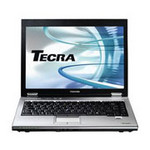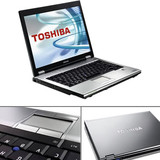Toshiba Tecra M9L
Specifications

Price comparison
Reviews for the Toshiba Tecra M9L
Source: IT Reviews
 Archive.org version
Archive.org versionToshiba's Tecra range of business notebooks may not be as well known as its Satellite range, but the Tecra product line is similarly being refreshed with the latest technologies on a constant basis. The latest additions to the Tecra line-up are the A9 and M9 series. The M9L-12T sits bang in the middle of the six-model M9 family and uses the latest Intel Santa Rosa mobile technology.
The latest Centrino platform, code-named Santa Rosa, features a new Core 2 Duo processor with an 800MHz FSB instead of the previous core's 667MHz, and a host of onboard power-saving features including dynamically switchable FSB speeds (so when the notebook is in a low power state, such as in DVD playback, the FSB throttles back), EDS (Enhanced Deeper Sleep) and Dynamic Acceleration Technology, an advanced version of Intel's Smart Cache technology.
Ausstattung gut
Single Review, online available, Medium, Date: 08/17/2007
Rating: features: 80%
Comment
Intel Graphics Media Accelerator (GMA) X3100: Intel Graphics Media Accelerator (GMA) X3100 is an integrated (onboard) graphic chip on a Mobile Intel 965GM chipset. It is the successor of GMA 950 and features a fully programmable pipeline (supports Aero Glass fully and DirectX 10 with newest drivers). The peformance of the X3100 is clearly better than the GMA 950, still demanding modern games won't run fluently.
These graphics cards are not suited for Windows 3D games. Office and Internet surfing however is possible.
» Further information can be found in our Comparison of Mobile Graphics Cards and the corresponding Benchmark List.
Intel Core 2 Duo: This is the Core Duo and Core Solo successor with a longer pipeline and 5-20% more speed without more power consumption. As an addition to the Core Duo design there exists a fourth decoder, an amplified SSE-unit and an additional arithmetical logical unit (ALU).
The Core 2 Duo for laptops is identical to the desktop Core 2 Duo processors but the notebook-processors work with lower voltages (0.95 to 1188 Volt) and a lower Frontside bus clock (1066 vs 667 MHz). The performance of equally clocked notebooks is 20-25% lower than Desktop PCs because of the lower Frontside bus clock and the slower hard disks.
T7100: Entry level to mid-range (at the time of annoucement) dual core processor based on the Merom core.» Further information can be found in our Comparison of Mobile Processsors.












